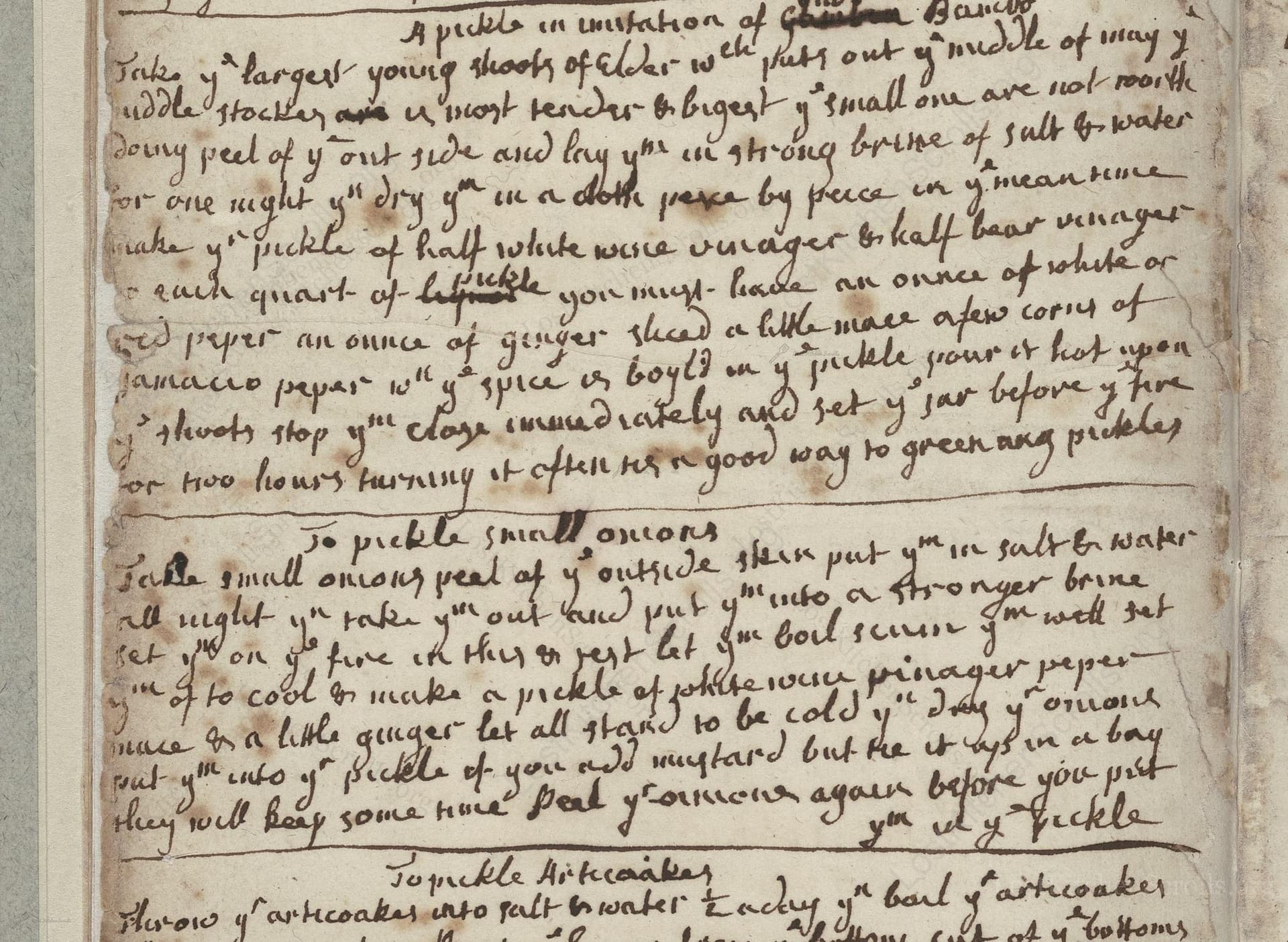A Pickle In Imitation Of Bambo
From the treasured pages of Mrs. Knight's receipt book
Written by Mrs. Knight

A Pickle In Imitation Of Bambo
"Take ye largest young shoots of elder wch puts out of ye middle of may ye middle stalkes are ye most tender & bigest ye small one are not worth doeing peel of ye out side and lay ym in strong brine of salt & water for one night yn dry ym in a cloth press by ye peice in ye mean time make ye pickle of half white wine vinager & half bear vinager to each quart of liquor you must have an ounce of white or red peper an ounce of ginger sliced a little jamaco peper wth ye spice is boyld in ye pickle pour it hot upon ye shoots stop ym close immediately and set by for use for a month before you use it this stopes ym from turning & stands for two hours turning it often is a good way to green any pickles"
Note on the Original Text
The recipe is written in the casual, instructive style typical of 18th-century manuscript cookery. Spelling is phonetic and standardized punctuation is rare: for instance, 'yt' means 'that', 'ym' is 'them', and 'bear vinager' is 'beer (malt) vinegar.' Quantities and timing are approximate, relying on the cook’s judgment. Directions are given in a flow rather than explicit steps, assuming familiarity with household processes such as brining and pickling.

Title
Mrs. Knight's receipt book (1740)
You can also click the book image above to peruse the original tome
Writer
Mrs. Knight
Era
1740
Publisher
Unknown
Background
Step into the refined kitchens of 18th-century England with Mrs. Knight’s culinary collection, where time-honored recipes, hearty roasts, and elegant pastries await the enterprising cook.
Kindly made available by
Folger Shakespeare Library
This delightful recipe comes from Mrs. Knight’s manuscript, dated around 1740. At the time, imported delicacies like preserved bamboo shoots were fashionable, yet rare and costly in Britain. Resourceful cooks imitated such luxuries using local ingredients—in this case, elder shoots reminiscent in form and texture to bamboo. The art of pickling was central to extending the brief British growing season's bounty, and the fragrant, spicy brine provided both preservation and subtle heat. This imitation pickle speaks to the culinary inventiveness of 18th-century British households and the early confluence of global influences (notably, the name-check of Jamaica pepper/allspice) with rural resourcefulness.

Cooks of the period would have used a sharp knife for peeling the shoots, a large earthenware or wooden bowl for brining, and heavy linen cloths for drying and pressing. The pickling mixture would have been boiled in a sturdy metal pan—often brass or copper. The hot liquid was poured into stoneware or glass jars, promptly sealed with waxed paper, leather, or a bladder to exclude air.
Prep Time
30 mins
Cook Time
15 mins
Servings
8
We've done our best to adapt this historical recipe for modern kitchens, but some details may still need refinement. We warmly welcome feedback from fellow cooks and culinary historians — your insights support the entire community!
Ingredients
- Young, thick elderberry shoots (Sambucus nigra), as available (about 1 lb)
- 3.5 oz salt
- 1 quart water
- 2 cups white wine vinegar
- 2 cups malt vinegar (substitute cider vinegar if needed)
- 1 oz black or pink peppercorns
- 1 oz fresh ginger, sliced
- A pinch of allspice berries or 1 small Scotch bonnet pepper (substitute for Jamaica pepper)
Instructions
- Begin by harvesting the largest, youngest shoots of elder (Sambucus nigra), ideally in mid-May.
- Peel away the tough outer layer from the thicker middle stalks—you want the plumpest and most tender ones.
- Place these shoots in a strong brine (dissolve about 3.5 oz salt in 1 quart of water) and soak overnight.
- The next day, drain and pat the shoots dry with a cloth, genty pressing each piece.
- Meanwhile, make the pickling liquor: for every quart of liquid, use half white wine vinegar and half malt vinegar.
- For each quart, add 1 oz of black or pink peppercorns, 1 oz of sliced fresh ginger, and a pinch of allspice or Scotch bonnet pepper as a substitute for 'Jamaica pepper' (allspice).
- Boil the spices in the vinegar mixture.
- Pour this hot mixture over the elder shoots in sterilized jars, seal immediatly, and leave for at least one month before enjoying.
- To help the shoots retain their color (a vibrant green), let them stand for 2 hours after pouring on the brine, turning them often.
Estimated Calories
10 per serving
Cooking Estimates
You will need to spend some time preparing the elder shoots and making the pickling liquid. Most of the time is for soaking and waiting, with very little active cooking. This recipe makes about 8 servings, considering typical pickled vegetable serving sizes. Pickled elder shoots are very low in calories—about 10 per serving.
As noted above, we have made our best effort to translate and adapt this historical recipe for modern kitchens, taking into account ingredients nowadays, cooking techniques, measurements, and so on. However, historical recipes often contain assumptions that require interpretation.
We'd love for anyone to help improve these adaptations. Community contributions are highly welcome. If you have suggestions, corrections, or cooking tips based on your experience with this recipe, please share them below.
Join the Discussion
Rate This Recipe
Dietary Preference
Main Ingredients

Den Bockfisch In Einer Fleisch Suppen Zu Kochen
This recipe hails from a German manuscript cookbook compiled in 1696, a time whe...

Die Grieß Nudlen Zumachen
This recipe comes from a rather mysterious manuscript cookbook, penned anonymous...

Ein Boudain
This recipe comes from an anonymous German-language manuscript cookbook from 169...

Ein Gesaltzen Citroni
This recipe, dating from 1696, comes from an extensive anonymous German cookbook...
Browse our complete collection of time-honored recipes



